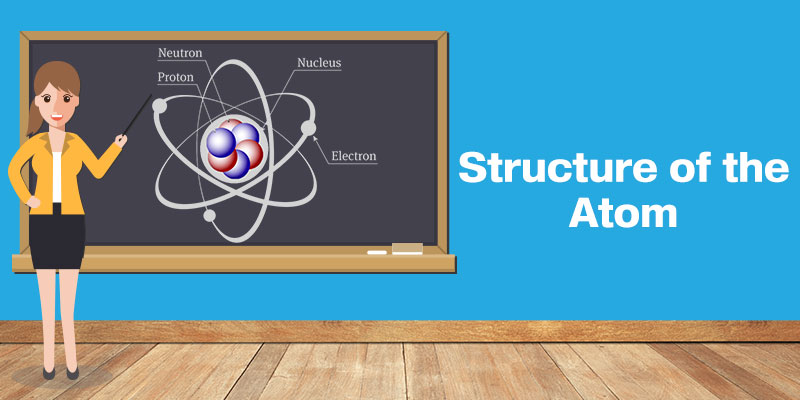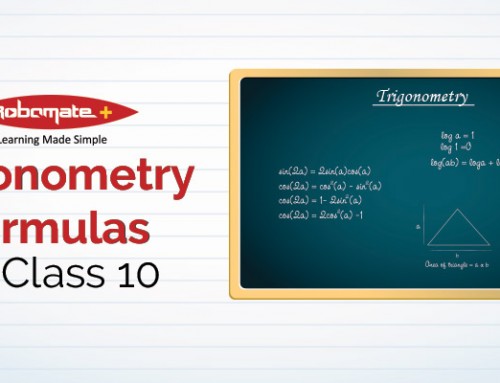NCERT Solutions for Class 9 Science Chapter 4 – Structure of the Atom
1)What are canal rays?
Soln:
Canal rays are radiations which are positively charged and was the key in the discovery of proton, another positively charged subatomic particle.
2) If an atom contains one electron and one proton, will it carry any charge or not?
Soln:
Since an electron is a negatively charged particle and the proton, a positively charged one, the net charge becomes neutral as both the particle neutralises each other.
3) On the basis of Thompson’s model of an atom, explain how the atom is neutral as a whole.
Soln: According to the Thompson’s model,
(i) An atom contains a positively charged sphere in which the negatively charged electrons are embedded.
(ii) In the system the number of protons and the electrons are equals therefore neutralising their charge keeping the overall system neutral.
4) On the basis of Rutherford’s model of an atom, which subatomic particle is present in the nucleus of an atom?
Soln: According to the Rutherford’s model of an atom, the positively charged protons are the ones that are present in the atom.
5) Draw a sketch of Bohr’s model of an atom with three shells.
Soln:

6) What do you think would be the observation if the – particle scattering experiment is carried out using a foil of a metal other than gold?
Soln:
When in the – particle scattering experiment, when any other metal foil is used instead of gold, the observation would remain the same. This is because the structure of an atom when considered individually remains the same.
7) Name the three subatomic particles of an atom.
Soln: An atom consists of three subatomic particles:
- Protons which are positively charged
- Electrons which are negatively charged
- Neutrons which are neutral in nature ( no charge )
8) Helium atom has an atomic mass of 4 u and two protons in its nucleus. How many neutrons does it have?
Soln:
Atomic mass = number of (protons + neutrons)
4= 2 + number of neutrons
Number of neutrons = 4 – 2 = 2
Therefore, Helium has 2 neutrons.
9) Write the distribution of electrons in Carbon and Sodium atoms.
Soln:
Carbon atom: Atomic number = 6
Number of protons = 6 = Number of electrons
Distribution = K-2 ; L-4
Sodium atom: Atomic number = 11
Number of protons = 11 = Number of electrons
Distribution = K-2 ; L-8 ; M-1
10) If K and L shells of a n atom are full, then what would be the total number of electrons in the atom?
Soln:
Number of electrons K shell can hold = 2
Number of electrons L shell can hold = 8
Hence, when both the shells are full, the total number of electrons present = 2+8 = 10 electrons.
11) How will you find the valency of Chlorine, Sulphur and Magnesium?
Soln:
The valency of an element is defined as its combining power with other atoms when it forms chemical compounds or molecule. It is measured by finding the number of electrons needed to complete the shell in which it is present or the excess electrons present after the filling is complete.
Chlorine: Atomic number = 17
Number of protons = Number of electrons = 17
Distribution: K-2 ; L-8 ; M-7
From the above observation, it is noticed that one more electron is required to fill the M shell. Hence its valency is ( -1 ) that is it is one electron less.
Sulphur: Atomic number = 16
Number of protons = Number of electrons = 16
Distribution: K-2 ; L-8 ; M-6
From the above observation. It is noticed that two more electrons are required to fill the M shell. Hence its valency is ( -2 ) that is it is two electrons less.
Magnesium: Atomic number = 12
Number of protons = Number of electrons = 12
Distribution: K-2 ; L-8 ; M-2
From the above observation, it is noticed that 6 more electrons are required to complete the M shell. However, M shell has only two electrons, it has less electrons than it requires to complete the arrangement. Therefore, this atom is unstable because of the presence of two electrons in the M shell. Therefore, its valency is ( +2 ) that is it is excess of two electrons.
12) If the number of electrons in an atom is 8 and number of protons is also 8, then
(a) What is the atomic number of the atom?
(b) What is the charge on the atom?
Soln:
Given: Number of electrons = 8
Number of protons = 8
(a) Atomic number of the atom = Number of protons = 8
(b) As the number of electrons is equal to the number of protons on the atom, their charges neutralise each other. Therefore, the atom does not possess any charge.
13) With the help of given Table, find out the mass number of Oxygen and Sulphur atom.
Table: Composition of Atoms of the First Eighteen Elements with Electron Distribution in Various Shells.
(a)
| Name of Element | Symbol | Atomic number | Number of Protons | Number of Neutrons | Number of electrons | Distribution of electronsK L M N | Valency | |||
| HydrogenHelium
Lithium Beryllium Boron Carbon Nitrogen Oxygen Fluorine Neon Sodium Magnesium |
HHe
Li Be B C N O F Ne Na Mg |
12
3 4 5 6 7 8 9 10 11 12 |
12
3 4 5 6 7 8 9 10 11 12 |
–2
4 5 6 6 7 8 10 10 12 12 |
12
3 4 5 6 7 8 9 10 11 12 |
12
2 2 2 2 2 2 2 2 2 2 |
––
1 2 3 4 5 6 7 8 8 8 |
––
– – – – – – – – 1 2 |
––
– – – – – – – — – – |
10
1 2 3 4 3 2 1 0 1 2 |
(b)
| AluminiumSilicon
Phosphorus Sulphur Chlorine Argon |
AlSi
P S Cl Ar |
1314
15 16 17 18 |
1314
15 16 17 18 |
1414
16 16 18 22 |
1314
15 16 17 18 |
22
2 2 2 2 |
88
8 8 8 8 |
34
5 6 7 8 |
––
– – –
|
34
3,5 2 1 0 |
Soln:
(a) Oxygen: Number of protons = 8
Number of neutrons = 8
Atomic number = 8
Atomic mass number = Number of ( protons + neutrons )
= 8 + 8 = 16
(b) Sulphur: Number of protons = 16
Number of neutrons = 16
Atomic number = 16
Atomic mass number = Number of ( protons + neutrons )
= 16 + 16 = 32
14) For the symbol H, D and T, tabulate three subatomic particles found in each of them.
Soln:
(a) H ( Protium ) (11H)
Atomic number = 1
Mass number = 1
Number of protons = 1
Number of electrons = 1
Number of neutrons = Nil
(b) D ( Deuterium ) ( 21H )
Atomic number = 1
Mass number = 2
Number of protons = 1
Number of electrons = 1
Number of neutrons = 1
(c) T ( Tritium ) ( 31H )
Atomic number = 1
Mass number = 3
Number of protons = 1
Number of electrons = 1
Number of neutrons = 2
15) Write the electronic configuration of any one pair of isotopes and isobar.
Soln:
(a) Isotopes: Isotopes are atoms which has the same number of protons but the number of neutrons differs. This leads to the variation in mass number too.
Example: The most simple example is the Carbon molecule which exists as 6C12 and 6C14 but when their electronic configuration is noticed, both have K-2 ; L-4
(b) Isobars: Isobars are atoms which has the same mass number but differ in the atomic number. Electronic configuration of an isobar pair is as follows,
20Ca40 :- K-2 ; L-8 ; M-8 ; N- 2
18Ar40 :- K-2 ; L-8 ; M-8
Exercises:
(1) Compare the properties of electrons, protons and neutrons.
Soln:
| Electrons | Protons | Neutrons |
| They are negatively charged | They are positively charged | They have no charge. |
| They are present outside the nucleus | They are present within the nucleus | They are present inside the nucleus of an atom |
| Negligible mass | 1 a.m.u | 1 a.m.u |
| Attracted towards positive charged | Attracted towards negative charged | Do not get attracted to any charged particle |
2) What are the limitations of J.J.Thomson’s model of the atom?
Soln:
- The model of an atom proposed by J.J Thomson states that in a positive sphere, are the negatively charged electrons embedded
- But he did not have any experimental evidence in his support.
- Also, the model was not able to explain the scattering of light experiment done by Rutherford.
3) What are the limitations of Rutherford’s model of the atom?
Soln: In the model that he suggested for atom, Rutherford states that the electrons revolve around the nucleus of an atom in the same way the earth revolves around the sun.
But, whenever this situation prevails, the revolving particle gains acceleration and radiates its energy outwards. With continuous radiation of energy, the atom would lose its energy and fall into the nucleus which when happens makes the atom highly unstable. But on the contrary, we find the atom as a highly stable particle which disproves the assumption.
4) Describe Bohr’s model of the atom.
Soln:
- The nucleus of an atom is present in the centre.
- Around this nucleus will revolve the negatively charged electrons.
- Discrete orbits of electrons are present inside the atom.
- While in this orbits, the electrons do not radiate energy.
- These discrete orbits are represented as K, L, M, N orbits or denoted with the numbers n=1, 2, 3, 4

5) Compare all the proposed models of an atom given in this chapter.
Soln:
| Thomson | Rutherford | Bohr |
| ● Positively charged sphere● The negatively charged electrons are spread randomly all over inside the sphere
● Positively charged = negatively charged ● The net charge in the atom is zero.
|
● Positively charged nucleus in the centre carrying the entire mass● The negatively charged electrons revolve in a well defined path
● The size of atom is very large as compared to nucleus.
|
● Positively charged nucleus in the centre● The negatively charged electrons revolving around do not radiate energy.
● Orbits are labelled as K, L, M, N or n=1, 2, 3, 4
|
6) Summarise the rules for writing of distribution of electrons in various shells for the first eighteen elements.
Soln:
- Generally, the maximum number of electrons that can be accommodated in a shell is given by the formula: 2n2 , where n= 1, 2, 3…
- Maximum number of electrons in different shells are:
K shell – n=1 ; 2n2 = 2(1)2 = 2
L shell – n=2 ; 2n2 = 2(2)2 = 8
M shell – n=3 ; 2n2 = 2(3)2 = 18
N shell- n=4 ; 2n2 = 2(4)2 = 32
- Given number of electrons is 18.
- The electrons are not taken in unless the inner shells are filled.
- Hence the highest element has K-2 ; L-8 ; M-8.
7) Define valency by taking examples of silicon and oxygen.
Soln:
The valency of an element is defined as its combining power with other atoms when it forms chemical compounds or molecule. It is measured by finding the number of electrons needed to complete the shell in which it is present or the excess electrons present after the filling is complete.
For example, take the example of silicon and oxygen.
| Oxygen | Silica |
| Atomic Number: 8 | Atomic Number: 14 |
| Electronic Config: K-2 ; L-6 | Electronic Config: K-2 ; L-8 ; M-4 |
| Valence electrons: 6 | Valence electrons: 4 |
| Valency: 8-6 = 2 | Valency: 8-4 = 4 |
8) Explain with examples;
(a) Atomic number
(b) Mass number
(c) Isotopes
(d) Isobars
Give any two uses of isotopes.
Soln:
(a) Atomic number of an atom is defined as the number of positively charged protons present in the atom nucleus. Example: Hydrogen has one proton in its nucleus, hence its atomic number is one.
(b) Mass number of an atom is defined as the total number of protons as well as neutrons. The take into account the elements that contribute to the atomic mass of the atom, since the mass of electrons are negligible as compared to the protons and neutrons of the corresponding element.
(c) Isotopes: Isotopes are atoms which has the same number of protons but the number of neutrons differs. This leads to the variation in mass number too.
Example: The most simple example is the Carbon molecule which exists as 6C12 and 6C14
(d) Isobars: Isobars are atoms which has the same mass number but differ in the atomic number. Examples are, 20Ca40 and 18Ar40
Uses of isotopes:
- The isotope of Iodine atom is used to treat goitre, and iodine deficient disease.
- Fuel for nuclear reactors are take care with the isotopes of Uranium atom.
9) Na+ has completely filled K and L shells. Explain.
Soln:
A sodium atom has 11 electrons in its orbitals, since its atomic number is 11 and has the same number of protons and electrons. Thus its electronic configuration is K-2 ; L-8 ; M-1 ; The one electron in the M shell is lost and it obtains a positive charge since it has one more proton than the electrons, and obtains a positive charge, Na+ . Now the configuration is K-1 ; L-8 which is the filled state. Hence it is very difficult to remove the electron form a filled state as it is very stable.
10) If Bromine atom is available in the form of say, two isotopes 35Br79 (49.7%) and 35Br81 (50.3%), calculate the average atomic mass of Bromine atom.
Soln:
The atomic masses of two isotopic atoms are 79 (49.7%) and 81 (50.3%).
Thus, total mass = (79 * 49.7100 ) + (81 * 50.3100)
= 39.263 + 40.743
= 80.006 u
11) The average atomic mass of a sample of an element X is 16.2 u. What are the percentages of isotopes 168X and 188X in the sample?
Soln:
Let the percentage of 168X be ‘p’ and that of 188X be ‘100-p’.
Hence, (16 * p100 ) + (18 * 100−p100)
= 16.2
= 16p100 + 1800−18p100
= 16.2
On solving the equation, we obtain ‘p’ to be 90.
Therefore, 168X = 90%
And , 188X = 10%
12) If Z=3, what would be the valency of the element? Also, name the element.
Soln:
Z = atomic number = 3 (given)
Electronic configuration = K-2 ; L-1
Thus, valency = 1
The element with atomic number 3 is Lithium.
13) Composition of the nuclei of two atomic species X and Y are given as under X-Y
Protons = 6-6
Neutrons = 6-8
Give the mass number of X and Y. What is the relation between the two species?
Soln:
Mass number of X: 6+6 = 12
Mass number of Y: 6+8 = 14
Since the atomic numbers of both the species are the same, they are the same element. Also since they have different number of neutrons, their mass number is different and they are the isotopes.
14) For the following statements, write T for true and f for false.
(a) J. Thomson proposed that the nucleus of an atom contains only nucleons.
(b) A neutron is formed by an electron and a proton combining together. Therefore it is neutral.
(c) The mass of an electron is about 1/2000 times that of proton.
(d) An isotope of iodine is used for making tincture iodine, which is used as a medicine.
Soln:
(a) False
(b) False
(c) True
(d) false
Put tick against correct choice and cross against wrong choice in questions 15, 16 and 17.
15) Rutherford’s alpha – particle scattering experiment was responsible for the discovery of
(a) Atomic nucleus
(b) Proton
(c) Electron
(d) neutron
Soln:
(a) Atomic nucleus
16) Isotopes of an element have
(a) The same physical properties
(b) Different number of neutrons
(c) Different number of protons
(d) Different atomic number
Soln:
(b) different number of neutrons
17) Number of valence electrons in Cl– ion are:
(a) 16
(b) 8
(c) 17
(d) 18
Soln:
(b) 8
18) Which one of the following is a correct electronic configuration of Sodium?
(a) 2, 8
(b) 8, 2, 1
(c) 2, 1, 8
(d) 2, 8, 1
Soln:
(d) 2, 8, 1
19) Complete the following table
| Atomic number | Mass number | Number of neutrons | Number of Protons | Number of electrons | Name of the atomic species |
| 916
– – – |
–32
24 2 1 |
10–
– – 0 |
––
12 1 1 |
––
– – 0 |
–Sulphur
– – – |
Soln:
| Atomic number | Mass number | Number of neutrons | Number of Protons | Number of electrons | Name of the atomic species |
| 916
12 1
1 |
1932
24 2
1 |
1016
12 1
0 |
916
12 1
1 |
916
12 1
0 |
FluorineSulphur
Magnesium Hydrogen. Deuterium Hydrogen |













